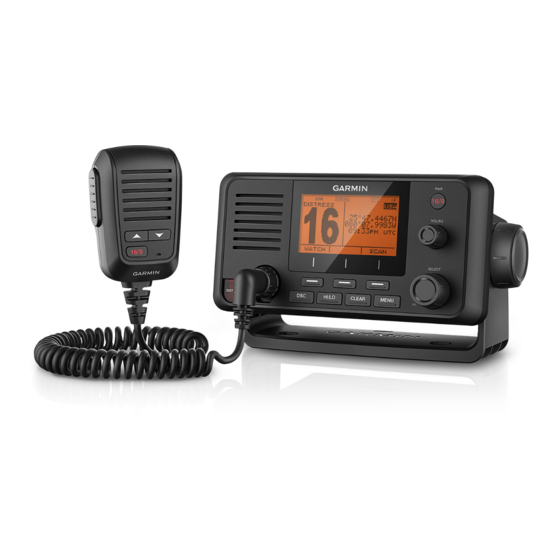Garmin VHF 110 Series 소유자 매뉴얼 - 페이지 10
{카테고리_이름} Garmin VHF 110 Series에 대한 소유자 매뉴얼을 온라인으로 검색하거나 PDF를 다운로드하세요. Garmin VHF 110 Series 22 페이지.

channel 70. After an acknowledgment is received, the radio
changes to the channel you selected for the call.
Placing Group Calls
Before you can place a call to a group, you must enter the MMSI
number of the group into the directory
page
8).
You can contact a group of specific vessels, such as a sailing
club or flotilla, by making a group call.
1
Select DSC > GROUP > CALL.
2
Select a saved group.
3
Select a channel
(Individual Call or Group Call Channels,
page
6).
The radio transmits the channel request with your call.
4
Select CALL.
The radio transmits the call on channel 70, then changes to
the selected channel.
Individual Call or Group Call Channels
When placing an individual or group call, you should select from
designated DSC channels. The radio transmits this request with
your call.
• USA: channels 6, 8, 9, 10, 13, 17, 67, 68, 69, 71, 72, 73, and
77.
• Canada and International: all USA channels, plus channel 15
DSC channels are limited to channels that are available in all
frequency bands. You can select CUSTOM to select a channel
that is not listed. If you select a custom channel, the station you
are calling may not be able to comply with the specified channel.
You should select a channel that is appropriate for
communication.
Placing All-Ships Calls
All-ships calls are transmitted to all stations within receiving
distance of your radio. You can make two types of all-ships
calls. Safety calls broadcast significant navigational or weather-
related information. Urgency calls communicate situations about
the safety of a vessel or person when danger is not imminent.
The captain should discern whether a situation warrants a safety
call or an urgency call.
1
Select DSC > ALL SHIPS.
2
Select SAFETY or URGENCY.
3
Select a channel
(Individual Call or Group Call Channels,
page
6).
The radio transmits the channel request with your call.
4
Select CALL.
The radio transmits the call on channel 70, then changes to
the selected channel.
Requesting a Vessel's Position
Position data received from stations that respond to position
request calls is sent over the NMEA
vessels on your Garmin chartplotter.
1
Select DSC > POS. REQUEST.
2
Select an option:
• To enter the MMSI number manually, select MANUAL,
enter the MMSI number, and select ACCEPT.
• To select an entry from the directory, select DIRECTORY,
and select an entry.
3
Select CALL.
The radio transmits the call on channel 70 and returns to the
previous channel. WAITING FOR ACKNOWLEDGE appears
on the screen.
6
(Adding a Group,
network. You can track the
®
Receiving Calls
Receiving Distress Calls and Distress Relay Calls
When receiving a distress call or a distress relay call,
DISTRESS or DISTR RELAY, and information about the call,
such as MMSI number and the nature of the distress, appear on
the radio screen. A distress call is sent from a vessel in need of
assistance, and a distress relay call is sent from either another
vessel or a station on behalf of a vessel in need of assistance.
The radio sends data related to the call over the NMEA network
based on how you configure MMSI filters
NMEA Transmissions, page
When a distress call is received, select an option:
• To view additional information about the distress call,
select
.
• To accept the distress call and switch to channel 16,
select OK.
• To ignore the distress call and stay on the current
channel, select CANCEL.
Receiving All-Ships Urgency and Safety Calls
When you receive an all-ships urgency or safety call, ALL
SHIPS appears on the screen, and URGENCY or SAFETY
appears as the type of call. If the channel request is for an
invalid channel, INVALID CH REQUEST appears on the screen.
When an urgency or safety call is received, select an option:
• To view additional information about the call, select
• To accept the call and switch to channel 16, select OK.
• To ignore the call and stay on the current channel, select
CANCEL.
Receiving Individual Routine Calls
When you receive an individual routine call, INDIVIDUAL
appears on the screen, and ROUTINE appears as the type of
call. If the channel request is for an invalid channel, INVALID CH
REQUEST appears on the screen.
When a call is received on a valid channel, select an option:
• To accept the call and switch to the requested channel,
select OK.
• To ignore the call and stay on the current channel, select
CANCEL.
Receiving Position Requests
You can configure the radio to reply automatically to incoming
position requests, prompt you to review and approve the
incoming requests before replying, or ignore incoming requests
(Sending Position Replies Automatically, page
When you receive a position request with automatic position
replies enabled, SENDING ACKNOWLEDGE appears on the
screen, and the radio sends your position automatically. After
the position successfully transmits, POSITION SENT appears
on the screen.
When you receive a position request with automatic position
replies disabled, POS. REQUEST appears on the screen.
When you receive a position request with automatic position
replies disabled, select OK, and select an option:
• To reply to the position request with your current position,
select OK.
If GPS-position or manual-position data is available, the
radio transmits your position to the other vessel.
• To ignore the position request, select CANCEL.
Receiving Position Calls
When you receive a position call, POS. SEND and the position
data appear on the screen.
Select OK.
(Configuring DSC
9).
8).
Digital Selective Calling
.
